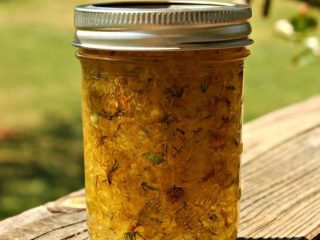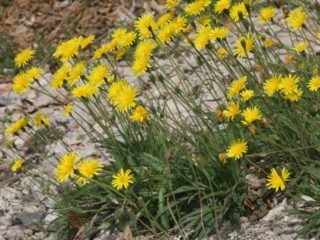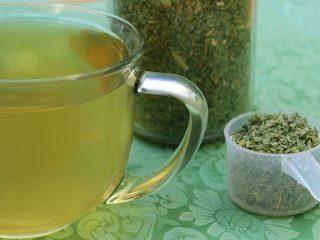Content
Yarrow Terracotta is a perennial of the Asteraceae family. The plant is not picky about the soil, so its places of growth in nature are different. It is found along roads or in open areas throughout the Russian Federation and Central Asia; after its appearance, it suppresses the growth of other garden crops. With sufficient space, when nothing interferes with development, it protects other plantings from insect attack.
History of origin
The plant was known back in the Middle Paleolithic era. According to one legend, the army of Alexander the Great used yarrow powder to heal wounds received in battle.
According to some information, the perennial was bred artificially by crossing several varieties. The healing properties of Terracotta have been known for many years.

Today, Yarrow Terracotta is recognized as a medicinal raw material in many countries.
Description of Yarrow Terracotta
The characteristics of yarrow depend on the variety.The difference lies in the color of the perennial flowers. The Terracotta bush reaches a height of 60-80 cm and a width of 60-80 cm.

The name Terracota yarrow is associated with the brown-orange color of the inflorescences
Stems
The stem of the Terracotta yarrow bush is erect with a rounded cut. The surface is slightly pubescent, the hairs are white. Gradual lignification towards the root collar is observed.

The perennial is resistant to wind - the stem does not break even in strong gusts, so it does not require support when planting
Leaves
The leaves of Yarrow Terracotta have a pinnately dissected complex shape, their color is gray-green. Fern leaves are small.

At the time of flowering of Terracotta yarrow, the leaves are practically invisible
Flowers
The flowers are collected in corymbose inflorescences. The yarrow variety Terracotta has an unusual brownish-orange color. At the end of the flowering season, the perennial fades in the sun and acquires an unusual golden hue.
The diameter of the baskets reaches 7 cm. The flowering period is about 45 days, its beginning most often in July. The petals of small flowers are densely spaced and the emanating aroma is pleasant.

If the weather is good, re-blooming occurs in August.
Root system
The rhizome of the perennial Terracotta is thick and branched. Spreads quickly. The fibrous branched shape of the roots determines resistance to drought.

With regular precipitation, watering is not required for yarrow
Seeds
The length of the resulting yarrow seeds is 1.5-2 mm. The shape is slightly curved. The surface is matte, slightly wrinkled, and there are no wings. The color is silver-gray, there is a wing-shaped edge.

The germination of Terracotta seeds lasts up to four years if properly stored.
Advantages and disadvantages
Terracotta is considered a cultivar that combined the benefits of weeds with the beauty of flowers. Yarrow can be planted in a variety of climates.

The culture does not lose its decorative effect for a long time and does not require special care
Pros:
- resistance to frost and drought, shelter for the winter period is not required;
- no special care required;
- healing properties;
- long flowering;
- beautiful and bright flowers with a pleasant aroma;
- not attacked by pests;
- disease resistance.
Minuses:
- suppresses other crops planted nearby;
- After the end of the flowering season, flower stalks need to be trimmed.
Planting Yarrow Terracotta
The stability of yarrow allows seeds to be planted in the ground; the plant quickly gains strength. But under harsh growing conditions, seedlings are obtained first. The timing largely depends on the region:
- in the middle zone, seedlings are made in early spring, planted in the ground in mid-May after the soil has warmed up;
- in the Urals, the dates are shifted to the second half of March and early June, respectively;
- In the warm weather of the southern regions, planting in the ground is done immediately in mid-April.

Yarrow is planted in compositions at the rate of seven plants per square meter
Terracotta seedlings are planted in boxes 8 cm high. The soil should be a mixture of three parts universal soil, part sand and part perlite. Sowing algorithm:
- The container is filled with prepared soil, leaving a couple of centimeters to the edge. Level and moisten with a spray bottle.
- Distribute the seeds at a distance of about 3 cm, sprinkle with soil on top. Re-hydrate.
- Cover with film to create a greenhouse effect.
The seedlings are placed in a warm place. For seedlings to emerge, a temperature of 25°C is required, after which it is reduced to 16°C. Every day the lid is opened for a few minutes to ventilate. A week after germination, the temperature is increased and daylight is also provided for at least 12 hours. As the top layer of soil dries, the seedlings are watered. After just two weeks, a complex composition for feeding is added.
Yarrow Terracotta loves light areas. Then it grows very quickly, the stem becomes strong, and no support is required. But you can plant the crop in the shade. At a height of 60 cm, the plant may be damaged by strong winds. Therefore, some summer residents create a support for the first few years, until the bush gets stronger.
Planting in the ground is carried out after the onset of warm weather. The distance between bushes must be at least 30 cm, otherwise weak seedlings will die. Make a hole under the earthen ball, place yarrow, and then water it abundantly.
Care for Yarrow Terracotta
Yarrow Terracotta is unpretentious. It only needs watering once a week in dry, stable weather. After moistening, the soil must be loosened.
Fertilizing is applied at the time of flowering, which will extend the budding period. You can use ready-made mineral compositions.

To prevent self-seeding, the inflorescences are cut off as they wilt; in addition, they spoil the appearance of Terracotta, as they dry out quickly
It is recommended to replant yarrow once every five years for the purpose of rejuvenation and for its natural reproduction.The frost resistance of the crop makes it possible not to create shelter for it. If the region experiences a strong drop in temperature in winter, you can arrange a substrate of dry leaves. As a rule, only young Terracotta plants need protection from the cold.
Pest and disease control
The perennial plant has good immunity. It is sometimes attacked by a cyst nematode. This manifests itself as small white cocoons, the leaves begin to thicken a little and become deformed.

The drugs Vidat and Nematorin are suitable for fighting nematodes.
Another common pest that attacks Terracotta yarrow is aphids. It feeds on the vital juices of the plant. With prolonged damage, the bush disappears.

The preparations Aktara, Tanrek and others are suitable for controlling aphids on yarrow.
At high humidity, the crop can be attacked by the striped weevil. Its effect is also detrimental to the bush.

For weevils, the plant is treated with Zeon or Karate
Reproduction methods
The plant is propagated by seeds and division. In the first case, planting material is collected after ripening, then in the spring it is planted to grow seedlings.
The seed method is quite long, so gardeners most often resort to the method of dividing the rhizome. It is carried out in early spring every three years. This period is enough for the bush to grow and gain strength. After careful division, Terracotta yarrow is planted in a new place, thoroughly watered and fed.

The extensive root system of Terracotta is quickly restored
Yarrow Terracotta in landscape design
The perennial crop is often planted on the site to decorate Moorish lawns.

Terracotta is suitable for single and group planting, but it should not be planted near other crops
In addition to the healing properties, they note the possibility of creating beautiful bouquets of their yarrow at the time of flowering. Thick, erect stems with bright flowers stand in water for a long time.

Many flower lovers like the aroma of yarrow
Conclusion
Yarrow Terracotta is suitable for planting in various regions. The plant is not afraid of severe frosts and drought. Minimal care is required, which consists of trimming dried inflorescences and replanting every five years. In this case, flowering lasts for at least one month, the flowers are bright, and the area is filled with a pleasant aroma.
Reviews of Yarrow Terracotta











